Far North QLD Branch Mt Carbine, the Green Tungsten Mine in FNQ
I have tramped around a few mines over the years and almost invariably it was an experience that was somewhat challenging to the visual, olfactory, and auditory senses.
Imagine my surprise, when on a recent AusIMM Far North Queensland Branch visit to the Mt Carbine tungsten mine, I encountered none of these things. To my astonishment I saw the mixing of old technology and innovation to recover a critical mineral from an historic stockpile, and a tailings dam with fish, water lilies and a neutral pH. To top it off, Mt Carbine tungsten mine is a great example of the Circular Economy at work.
And how did this happen – well it’s a tale of a father and son, Kevin MacNeill, and his son Ryan, trapped in the far north by the COVID-19 pandemic. And that tale is theirs to tell!
EQ Resources
Mt Carbine Tungsten Mine was acquired by EQ Resources in 2019. The company entered a joint venture with CRONIMET Group, a global commodities trader, and metals recycling group with expertise in the use of sensor-based sorting technologies, to refurbish, commission and ramp up the tungsten processing plant at Mt Carbine.
Recovering the tungsten ore: the process
The process of recovering the tungsten ore from the historic stockpiles is where simplicity and innovation meet. The ore is passed through the XRT Sorter which identifies ore suitable for further treatment. This is then sent to the processing plant where it undergoes the age old process of jigging before moving across the Shaker Table where it is sorted further into tungsten concentrate or by-products which are used in local building projects and to maintain regional roads.
Sensor Based Sorting (XRT) technology
A Tomra X-Ray transmission ore sorter provides the innovation needed to reprocess historic stockpiles on this site. Described to me as resembling the technology used to scan baggage at an airport, this Sensor Based Sorting (XRT) technology was optimised to recognise the presence of tungsten in the ore feed. This reduces the amount of time and energy needed to reprocess the historic stockpiles with only the most viable ore going to the shaker tables for further treatment. This low energy technology is revolutionising and optimising the economic recovery of tungsten at Mt Carbine.
And, it has created a useful and lucrative ‘by-product’: road base and aggregate materials, products utilised extensively on the roads of far north Queensland.
Shaker Tables
Shaker tables are something that I had read about and seen in museums, and I did not expect to see it at Mt Carbine - but here, this low-technology equipment is used to grade the ore.
The Shaker Table works by separating the heavy material from light material by using their different proportions and specific gravity. Under the effect of gravity, the minerals divide into the ore concentrate, the middling and the tailing. The table’s riffles or channels taper downwards, separating out the ore, with the tungsten concentrate discharging at the end of the table.
The Shaker Table has persisted into the 21st century. It is a masterpiece of design with its prominent advantage being its ability to precisely separate the ore, with up to 95% recovery ratio for some heavy metals, tungsten ore and tin ore.[1]
From an environmental perspective, this recovery method is on-point, with the only input being water and this is recycled and reused by the company.
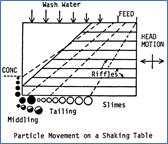
Figure 2: Shaker table
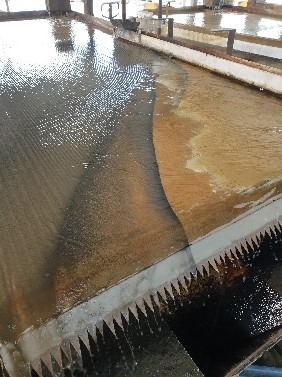
Plate 1: Shaker Table, Mt Carbine Mine
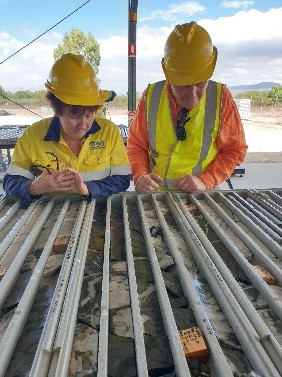
Plate 2: Justine Thorp and Athy Nye discussing core samples, Mt Carbine Mine
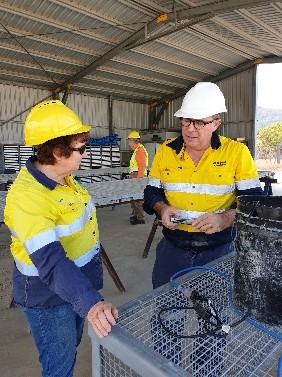
Plate 3: Justine Thorp and Kevin MacNeill discussing ore samples, Mt Carbine Mine
[1] JXSC Machine, Gold Shaking Tables Selection. https://www.jxscmachine.com/new/gold-shaking-tables-selection/ Accessed 3 September 2016.
[2] Schematic diagram of Shaker Table. https://www.google.com/search?q=mineral%20processing%20shaking%20table&tbm=isch&rlz=1C1EJFC_enAU936AU941&hl=en&sa=X&ved=0CCUQtI8BKANqFwoTCJC4h77x4fICFQAAAAAdAAAAABAH&biw=1903&bih=1057#imgrc=ES58qUmRI28GeM. Accessed 3 September 2021
Circular Economy
EQ Resources has embraced the concept of the Circular Economy. The application of this concept is evident throughout the site with the reuse of water at the processing plant, the use of innovation to identify suitable ore for treatment and the use of ‘by-products’ to supply road base and aggregate materials to build local roads and construction projects.
These are excellent examples of minimising harm to the environment through the reuse of historic stockpiles and creating value and ultimately prosperity. It works by extending the product lifespan through improved design and servicing and relocating waste from the end of the supply chain to the beginning—in effect, using resources more efficiently by using them over and over, not only once.
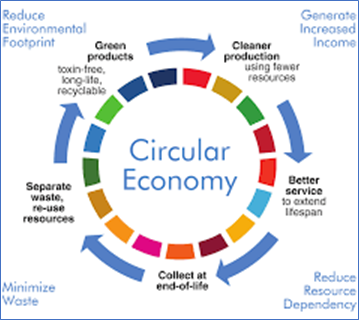
Figure 3: The Circular Economy
[3] Schematic of the Circular Economy. https://www.google.com/search?q=circular+economy+graphic&rlz=1C1EJFC_enAU936AU941&source=lnms&tbm=isch&sa=X&ved=2ahUKEwjFiIec-uHyAhURWCsKHQZjCT8Q_AUoAXoECAEQAw&biw=1920&bih=1057#imgrc=EgdXk-AFbtzKTM Accessed 3 September 2021.